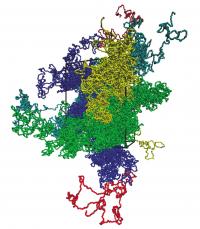
This image shows a DNA computer simulation. DNA carries out its activities "diluted" in the cell nucleus. In this state it synthesises proteins and, even though it looks like a messy tangle of thread, in actual fact its structure is governed by precise rules that are important for it to carry out its functions. Biologists have studied DNA by observing it experimentally with a variety of techniques, which have only recently been supplemented by research in silico, that is to say, the study of DNA by means of computer simulations. This is a recent area of study, but it has already given a major contribution to knowledge in this field. Angelo Rosa, a theoretical physicist of the International School for Advanced Studies (SISSA) in Trieste, with the collaboration of Christophe Zimmer, an experimental physicist from the Pasteur Institute in Paris has assessed the state of the art of this novel but powerful approach in a systematic review that has just been published in the journal International Review of Cell and Molecular Biology.
"Apart from some rare exceptions, we reviewed virtually all of the models developed to date", explains Rosa. "The review is mainly aimed at biologists in that we have made minimal use of mathematical formulas which hamper reading. I think this is the first review of its kind. The paper is actually also interesting for physicists and mathematicians who are approaching this new field for the first time".
The two physicists reviewed 25 years of computational models: "in this relatively short time span the models have become increasingly sophisticated and this, thanks to the development of computers", explains Rosa. "Today we are able to make far more detailed and predictive simulations, which allow us to lead the work of experimental researchers in previously unthought-of directions".
"This is a useful tool which, without going into mathematical detail, provides the biologist with an overview of the type of studies that will increasingly complement the more traditional approaches" continues Rosa. "Today, for example, we already have software programmes which, starting from experimental data, allow us to reconstruct the structure of specific portions of chromosomes. I think that if computers continue to evolve as they have done until now – and there's no reason to doubt this – we'll be able to reconstruct entire chromosomes".
"At the present time, the future prospects of in silico research into nuclear DNA are twofold", concludes Rosa, "to understand in detail the dynamics of gene expression (the details of protein synthesis) and to identify precisely where the chromosomes are when DNA unravels in the nucleus".
Source : comunicazione@medialab.sissa.it
 Print Article
Print Article Mail to a Friend
Mail to a Friend
